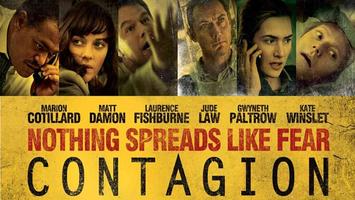
Over the last year of the COVID pandemic, we’ve heard over and over that “we’re all in this together,” But the quality (and “quantity”) of public health services for poor and working-class families was an issue before the Covid-19 pandemic. It turns out that working people — especially migrant laborers, hospital workers, teachers, cleaners, deliverers, security guards, fire and rescue teams, restaurant and hotel workers, and retail workers– bear a much greater burden and danger during any kind of epidemic, pandemic, or unnatural catastrophe. And even in the best of times, the vast numbers of underemployed, underpaid, and temporary workers of the world are not ideally situated to survive a pandemic economically or even literally. The precariat has been hit especially hard.
For many years I taught cultural studies film courses on epidemics and catastrophes. For films about the usual epidemic culprits such as viruses or bacteria, I used to concentrate on mainly medical indicators, such as the identification of the pathogenic vector, the geographic origin of the epidemic, the search for Patient Zero (the first victim of the disease), the symptoms of the afflicted, and how the pathogens circulate. We also talked about indicators that went beyond medical matters, especially class, ethnicity, race, and other political questions. We studied ethnic and racial neglect in medical access, the role of Big Pharma in controlling medications, especially pain-killers and vaccines, the tendency to idealize the White middle-class family, and governmental indifference or disbelief in the scale of the epidemic.
Epidemic cinema provides revealing examples of medical practices and social structures relevant to COVID-19. The Hot Zone (2019), a recent TV series about an outbreak of the Ebola virus among monkeys shipped from Africa to a private distributor for research labs in Reston, Virginia, for example, reveals how an epidemic scare alternates between competency and panic. When cases in local hospitals with alarming symptoms begin to appear, government agencies rush to conceal the outbreak while the press struggles to reveal the crisis. Charlatans appear peddling miraculous botanical cures. The series also shows the research of dedicated medical professionals establishing that the Ebola strain was specific to monkeys not humans.
A documentary, The Polio Crusade (2009), provides a revealing contrast to our current obsession with vaccines, tracing the pursuit of a polio virus vaccine at mid-century. Virtually no government financing for such research was available, so private organizations launched grassroots campaigns (The March of Dimes, for example) to raise money for vaccine research and even such medical equipment as iron lungs. One of the most famous competitions for a successful vaccine was played out between the “live virus” vaccine of Albert Sabin and the “killed virus” vaccine of Jonas Salk.
These examples make clear that epidemic cinema has much to teach us about pathogenic epidemics. But we can also learn from films about non-pathogenic epidemics, catastrophes that disproportionately affected the poor, the precariat, and the working class. Black and ethnic communities have been especially vulnerable to these. In A New Species of Trouble: The Human Experience of Modern Disasters (1994), Kai Erikson called these non-pathogenic epidemics “a new species of trouble.” These were not accidents, because they are all “produced by human hands,” “involve some kind of contaminant,” and are “chronic.” They gather “force slowly and insidiously,” and they persist because people “have been misinformed” about them. The storage of nuclear waste in Yucca Mountain in Nevada in 1977, for example, was not an “accident” but the deliberate misuse of Native American land that led to radioactive contamination.
Films about non-pathogenic epidemics show how they have impacted workers disproportionally, in part because of where they live, where they work, and the nature of their work. Judith Helfand’s landmark documentary, Cooked: Survival by Zipcode, chronicles the terrible heat wave in 1995 that killed 739 mostly African-American residents of one Chicago zipcode. Their housing was substandard, they had little or no access to healthcare, they lived in “food deserts” with no access to grocery stores, and they were afraid to leave their stifling apartments when the outside temperatures reached 107 degrees. Most of these tropes were also common in communities devastated by pathogenic vectors in epidemic cinema.
Read the rest of this piece at Working-Class Perspectives.
Tom Zaniello is a film and media scholar who has written several books on films about work and class, including Working Stiffs, Union Maids, Reds, and Riffraff, The Cinema of Globalization, and The Cinema of the Precariat.












